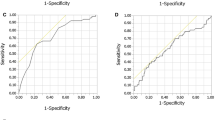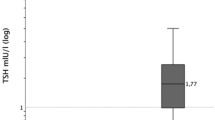Abstract
Hypercalcemia is relatively rare but clinically important complication in childhood leukemic patients. To clarify the clinical characteristics, mechanisms of hypercalcemia, response to management for hypercalcemia, incidence of t(17;19) and final outcome of childhood acute lymphoblastic leukemia (ALL) accompanied by hypercalcemia, clinical data of 22 cases of childhood ALL accompanied by hypercalcemia (>12 mg/dl) reported in Japan from 1990 to 2005 were retrospectively analyzed. Eleven patients were 10 years and older. Twenty patients had low white blood cell count (<20 × 109/l), 15 showed hemoglobin⩾8 g/dl and 14 showed platelet count ⩾100 × 109/l. Parathyroid hormone-related peptide (PTHrP)-mediated hypercalcemia was confirmed in 11 of the 16 patients in whom elevated-serum level or positive immunohistochemistry of PTHrP was observed. Hypercalcemia and accompanying renal insufficiency resolved quickly, particularly in patients treated with bisphosphonate. t(17;19) or add(19)(p13) was detected in five patients among 17 patients in whom karyotypic data were available, and the presence of E2A-HLF was confirmed in these five patients. All five patients with t(17;19)-ALL relapsed very early. Excluding the t(17;19)-ALL patients, the final outcome of ALL accompanied by hypercalcemia was similar to that of all childhood ALL patients, indicating that the development of hypercalcemia itself is not a poor prognostic factor.
This is a preview of subscription content, access via your institution
Access options
Subscribe to this journal
Receive 12 print issues and online access
$259.00 per year
only $21.58 per issue
Buy this article
- Purchase on Springer Link
- Instant access to full article PDF
Prices may be subject to local taxes which are calculated during checkout


Similar content being viewed by others
References
Mundy GR, Ibbotson KJ, D'Souza SM, Simpson EL, Jacobs JW, Martin TJ . The hypercalcemia of cancer. Clinical implications and pathogenic mechanisms. N Engl J Med 1984; 310: 1718–1727.
McKay C, Furman WL . Hypercalcemia complicating childhood malignancies. Cancer 1993; 72: 256–260.
Rheingold SR, Lange BJ . Supportive care of children with cancer: Oncology emergencies: Hypercalcemia. In: Pizzo PA and Poplack DG (eds). Principles and Practice of Pediatric Oncology, 4th edn. Williams & Wilkins, 2002, pp 1197–1198.
Seymour JF, Gagel RF . Calcitriol: the major humoral mediator of hypercalcemia in Hodgkin's disease and non-Hodgkin's lymphomas. Blood 1993; 82: 1383–1394.
Burtis WJ, Brady TG, Orloff JJ, Ersbak JB, Warrell Jr RP, Olson BR et al. Immunochemical characterization of circulating parathyroid hormone-related protein in patients with humoral hypercalcemia of cancer. N Engl J Med 1990; 322: 1106–1112.
Akatsu T, Takahashi N, Udagawa N, Sato K, Nagata N, Moseley JM et al. Parathyroid hormone (PTH)-related protein is a potent stimulator of osteoclast-like multinucleated cell formation to the same extent as PTH in mouse marrow cultures. Endocrinology 1989; 125: 20–27.
Harutsumi M, Akazai A, Kitamura T, Manki A, Tanaka H, Oda M et al. A case of acute lymphoblastic leukemia accompanied with the production of parathyroid hormone-related protein. Miner Electrolyte Metab 1995; 21: 171–176.
Hibi S, Funaki H, Ochiai-Kanai R, Ikushima S, Todo S, Sawada T et al. Hypercalcemia in children presenting with acute lymphoblastic leukemia. Int J Hematol 1997; 66: 353–357.
Shimonodan H, Nagayama J, Nagatoshi Y, Hatanaka M, Takada A, Iguchi H et al. Acute lymphocytic leukemia in adolescence with multiple osteolytic lesions and hypercalcemia mediated by lymphoblast-producing parathyroid hormone-related peptide: a case report and review of the literature. Pediatr Blood Cancer 2005; 45: 333–339.
Inaba T, Roberts WM, Shapiro LH, Jolly KM, Raimondi SC, Smith SD et al. Fusion of the leucine zipper gene HLF to the E2A gene in human acute B-lineage leukemia. Science 1992; 257: 531–534.
Hunger SP, Ohyashiki K, Toyama K, Cleary ML . Hlf, a novel hepatic bZIP protein, shows altered DNA-binding properties following fusion to E2A in t(17;19) acute lymphoblastic leukemia. Genes Dev 1992; 6: 1608–1620.
Look AT . Oncogenic transcription factors in the human acute leukemias. Science 1997; 278: 1059–1064.
Hunger SP . Chromosomal translocations involving the E2A gene in acute lymphoblastic leukemia: clinical features and molecular pathogenesis. Blood 1996; 87: 1211–1224.
Devaraj PE, Foroni L, Sekhar M, Butler T, Wright F, Mehta A et al. E2A/HLF fusion cDNAs and the use of RT-PCR for the detection of minimal residual disease in t(17;19)(q22;p13) acute lymphoblastic leukemia. Leukemia 1994; 8: 1131–1138.
Takahashi H, Goto H, Funabiki T, Fujii H, Yamazaki S, Fujioka K et al. Expression of two types of E2A-HLF fusion proteins in YCUB-2, a novel cell line established from B-lineage leukemia with t(17;19). Leukemia 2001; 15: 995–997.
Matsunaga T, Inaba T, Matsui H, Okuya M, Miyajima A, Inukai T et al. Regulation of annexin II by cytokine-initiated signaling pathways and E2A-HLF oncoprotein. Blood 2004; 103: 3185–3191.
Yoshihara T, Inaba T, Shapiro LH, Kato JY, Look AT . E2A-HLF-mediated cell transformation requires both the trans-activation domains of E2A and the leucine zipper dimerization domain of HLF. Mol Cell Biol 1995; 15: 3247–3255.
Inukai T, Inaba T, Yoshihara T, Look AT . Cell transformation mediated by homodimeric E2A-HLF transcription factors. Mol Cell Biol 1997; 17: 1417–1424.
Inaba T, Inukai T, Yoshihara T, Seyschab H, Ashmun RA, Canman CE et al. Reversal of apoptosis by the leukaemia-associated E2A-HLF chimaeric transcription factor. Nature 1996; 382: 541–544.
Inukai T, Inaba T, Ikushima S, Look AT . The AD1 and AD2 transactivation domains of E2A are essential for the antiapoptotic activity of the chimeric oncoprotein E2A-HLF. Mol Cell Biol 1998; 18: 6035–6043.
Inukai T, Inaba T, Dang J, Kuribara R, Ozawa K, Miyajima A et al. TEF, an antiapoptotic bZIP transcription factor related to the oncogenic E2A-HLF chimera, inhibits cell growth by down-regulating expression of the common beta chain of cytokine receptors. Blood 2005; 105: 4437–4444.
Smith KS, Rhee JW, Naumovski L, Cleary ML . Disrupted differentiation and oncogenic transformation of lymphoid progenitors in E2A-HLF transgenic mice. Mol Cell Biol 1999; 19: 4443–4451.
Honda H, Inaba T, Suzuki T, Oda H, Ebihara Y, Tsuiji K et al. Expression of E2A-HLF chimeric protein induced T-cell apoptosis, B-cell maturation arrest, and development of acute lymphoblastic leukemia. Blood 1999; 93: 2780–2790.
Hunger SP, Devaraj PE, Foroni L, Secker-Walker LM, Cleary ML . Two types of genomic rearrangements create alternative E2A-HLF fusion proteins in t(17;19)-ALL. Blood 1994; 83: 2970–2977.
Tsuchida M, Ikuta K, Hanada R, Saito T, Isoyama K, Sugita K et al. Long-term follow-up of childhood acute lymphoblastic leukemia in Tokyo Children's Cancer Study Group 1981-1995. Leukemia 2000; 14: 2295–2306.
Yamaguchi K, Kiyokawa T, Watanabe T, Ideta T, Asayama K, Mochizuki M et al. Increased serum levels of C-terminal parathyroid hormone-related protein in different diseases associated with HTLV-1 infection. Leukemia 1994; 8: 1708–1711.
Kurosawa H, Goi K, Inukai T, Chang KS, Shinjyo T, Rakestraw KM et al. Two candidate downstream target genes for E2A-HLF. Blood 1999; 93: 321–332.
Tamura T, Udagawa N, Takahashi N, Miyaura C, Tanaka S, Yamada Y et al. Soluble interleukin-6 receptor triggers osteoclast formation by interleukin 6. Proc Natl Acad Sci USA 1993; 90: 11924–11928.
Kudo O, Fujikawa Y, Itonaga I, Sabokbar A, Torisu T, Athanasou NA . Proinflammatory cytokine (TNFalpha/IL-1alpha) induction of human osteoclast formation. J Pathol 2002; 198: 220–227.
Niizuma H, Fujii K, Sato A, Fujiwara I, Takeyama J, Imaizumi M . PTHrP-independent hypercalcemia with increased proinflammatory cytokines and bone resorption in two children with CD19-negative precursor B acute lymphoblastic leukemia. Pediatr Blood Cancer 2006, (E-pub aheadof print).
Gurney H, Grill V, Martin TJ . Parathyroid hormone-related protein and response to pamidronate in tumour-induced hypercalcaemia. Lancet 1993; 341: 1611–1613.
Young G, Shende A . Use of pamidronate in the management of acute cancer-related hypercalcemia in children. Med Pediatr Oncol 1998; 30: 117–121.
Lteif AN, Zimmerman D . Bisphosphonates for treatment of childhood hypercalcemia. Pediatrics 1998; 102: 990–993.
Daheron L, Brizard F, Millot F, Cividin M, Lacotte L, Guilhot F et al. E2A/HLF fusion gene in an acute lymphoblastic leukemia patient with disseminated intravascular coagulation and a normal karyotype. Hematol J 2002; 3: 153–156.
Yeung J, Kempski H, Neat M, Bailey S, Smith O, Brady HJ . Characterization of the t(17;19) translocation by gene-specific fluorescent in situ hybridization-based cytogenetics and detection of the E2A-HLF fusion transcript and protein in patients' cells. Haematologica 2006; 91: 422–424.
Acknowledgements
We thank Masahiro Tsuchida (Department of Pediatrics, Ibaraki Children's Hospital, Mito, Japan) for providing the clinical data of TCCSG and Keiko Kagami (Department of Pediatrics, University of Yamanashi, School of Medicine) for technical supports.
Author information
Authors and Affiliations
Corresponding author
Rights and permissions
About this article
Cite this article
Inukai, T., Hirose, K., Inaba, T. et al. Hypercalcemia in childhood acute lymphoblastic leukemia: frequent implication of parathyroid hormone-related peptide and E2A-HLF from translocation 17;19. Leukemia 21, 288–296 (2007). https://doi.org/10.1038/sj.leu.2404496
Received:
Revised:
Accepted:
Published:
Issue Date:
DOI: https://doi.org/10.1038/sj.leu.2404496
Keywords
This article is cited by
-
Functional characterization of ABCA4 genetic variants related to Stargardt disease
Scientific Reports (2022)
-
Hypercalcemia, hyperuricemia, and kidney dysfunction in a 35-month-old boy: Answers
Pediatric Nephrology (2021)
-
Comprehensive chromosomal aberrations in a case of a patient with TCF3-HLF-positive BCP-ALL
BMC Medical Genomics (2020)
-
Life-threatening Hypercalcemia as the First Manifestation of Acute Lymphoblastic Leukemia
Indian Pediatrics (2019)
-
Prediction of venetoclax activity in precursor B-ALL by functional assessment of apoptosis signaling
Cell Death & Disease (2019)



